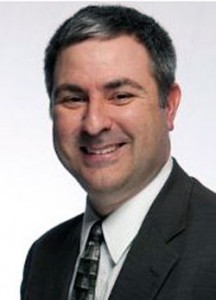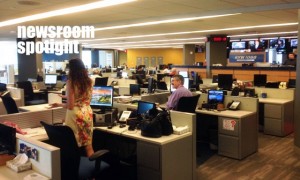
Editor’s Note: This Q&A is part of “Newsroom Spotlight,” a series of conversations with journalists about what’s going on in their newsrooms and the media industry. The interview excerpts have been lightly edited and organized for clarity. The interviewer was a part-time reporter for WDEL in summer 2014.
Chris Carl, 44, has been working at radio station WDEL in Wilmington, Delaware, for 20 years, starting with a part-time gig as a cub reporter, which led to an award-winning career in local radio and a stint as chair of the Radio Television Digital News Association.
Promoted to director of news and programming at WDEL in 2008, Carl describes his staff as fairly large for a mid-sized market (No. 79.) It includes six full-time news staffers, three full-time sports reporters and three full-time traffic reporters, plus talk-show hosts, production personnel and about five part-timers.
“If you break down the six full-timers,” he explained, “you have two guys who are mainly anchors, and then you have three reporters who are out on the street during the day.”
WDEL is a foreunner of radio newsrooms where reporters produce daily news reports for radio, along with video and text for the web. It recently added an FM frequency, simulcasting the AM programming. “It is a critical component to our survival,” Carl said.
American Journalism Review: Tell us about your newsroom operation.
Chris Carl: Each reporter is basically reporting one, if not two, big stories where they are producing video and audio. Then through the course of the day they, as well as the anchors, are writing quick briefs. We recently added a digital reporter, whose main responsibility is wdel.com, but who is also writing quick radio stories here and there. During the course of any given day, we are producing a dozen to maybe 15, 18, 20 stories. These stories are somewhat perishable – they are only going to run for up to 18 hours. Rarely does a story run for 24 hours because we are constantly turning out new information.
AJR: What key experiments are underway in your newsroom?
Carl: The addition of a digital reporter – DJ McAneny is his name – for a radio station of this size market, I’m pretty sure, is unheard of. I don’t know of any other station that is doing that. It’s part of our transformation from being a radio station, which is what we’ve been since 1922, to a digital organization. DJ is his name – his main responsibility is the website. He makes sure all stories get copy edited; he may add info to a story because a typical radio story is going to be 20 seconds long, only four to six lines. The digital story needs to be more for the user to get a more in-depth experience. He adds details we wouldn’t necessarily do on the radio such as specific addresses and names. He is also providing content to the site.
AJR: How does your newsroom approach packaging stories for the web?
Carl: We provide video, pictures and text when possible, and big stories include our on-air report.
AJR: Please describe any new websites (especially ones aimed at niche audiences) that your news organization has started in the last two years.
Carl: We launched our new website Oct. 1. We tried to make it more visual. We made text bigger and enlarged the video player. We were told our old site was too cluttered – too much going on. So we increased the font on the headline; we increased the white space.
AJR: Let’s talk mobile. How is your newsroom is approaching storytelling for mobile devices?
Carl: At the end of the day we are still a radio news operation. I don’t know if we are really doing anything different for mobile. I think we are doing better for writing for digital. We started rendering our videos as mp4s so they can play on mobile devices.
AJR: Which media companies do you think are disrupting the news media landscape? How and why?
Carl: As far as radio companies go, Hubbard’s WTOP-FM has done a great job. They understand that they must be digital and have a whole digital staff just for their website. It’s not radio people trying to do web. It’s radio people communicating with the digital staff and then them taking that ball and running with it. We modeled a lot of what they are doing and wish we could do more. They’ve done a good job separating and becoming that digital news operation that I think we are all striving to be.
AJR: Describe the most innovative thing your newsroom has done in the last year.
Carl: It’s all kind of a blur because we are doing so much. We got Facebook and Twitter, and we are using those to get photo galleries on the web.
AJR: What emerging technologies or storytelling methods are you trying to learn more about because they have the potential to impact news?
Carl: I hear of some news organizations starting to use Snapchat, and I am not really sure how they are doing it. The media is always looking to get a younger audience but we aren’t [reaching] the young audience [much]. We are trying to figure out where millennials are getting their news, and we’re trying to be a player in that. More than anything, we are trying to promote brand awareness, so when they do “grow up” and want to consume news in a more traditional way, they know where to turn. They will be familiar with our brand and know who we are, and I think all news organizations are trying to do that.
AJR: How does your newsroom use analytics to make daily coverage decisions?
Carl: We’re very much a local news organization. A lot of what we do is basically local news. People contact us with ideas, press releases and stuff like that. You have to know what’s important to your audience and what they need to know. What they want is the entertainment news, but there are certain stories that aren’t as sexy, per se, but … there is a certain obligation in what we do. We are going to report stuff that the might not really crave but we feel they need to know.
AJR: Tell us about your newsroom’s social media efforts. Are all reporters required to use social media to promote their stories?
Carl: There is no official policy. The younger the reporter, the more they will use social media. All stories go to Twitter and a select few go to Facebook. We don’t want to put everything on Facebook. People don’t go to Facebook to learn about the latest shooting in Wilmington. People are using Facebook to be entertained, so we will put more entertaining stories there. We do know for a fact that there is an audience out there that consumes us completely through digital and probably never turns on the radio. We are making our money on radio, we are making some on digital and we will make more money on digital once advertisers realize the audience is out there and that they can reach these people through the digital means. Right now advertisers – not all, but most –are not embracing the digital components of what we do.
AJR: What are your most successful efforts in obtaining user-generated content for your website?
Carl: We have not been as successful as I would like. We did put out a call during snowstorms saying, “Hey, if you got a good picture, send it to us,” and we got a pretty good response. We get a lot of tips on stuff that is happening. We don’t get a lot of user-generated material. In some senses, that is fine because we don’t want to get duped on anything either. I know some organizations are struggling with finding ways to vet the user-generated content to make sure it has not been Photoshopped or staged. I think for the most part, the audience is pretty genuine – what they say and shot are true, they are not trying to pull the wool over our eyes – but I know that happens. There are people out there who want to play games to see if they can get it on the news. I’m not sure why we haven’t gotten a bigger response. Emailing video is not very easy.
AJR: Does your news organization hold events? If so, what types?
Carl: The promotions department holds events. In the newsroom, we produced six or seven political debates last campaign. Some were open to the public; some were just in the studio. We’ve done town hall meetings in the past about city issues.
AJR: On a scale of 1 to 5 , how optimistic are you about the future of news? On that scale, 5 would be “very optimistic.”
Carl: I would say 5 because I think for local news there are not many outlets that do what we do. Radio in general, I’m not sure. But as long as we stay local with news, traffic and weather and continue to interact with our listeners, I think the future of radio is very strong. You have to be engaging if you want to survive.







